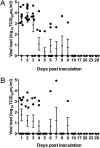Replication and shedding of MERS-CoV in Jamaican fruit bats (Artibeus jamaicensis)
- PMID: 26899616
- PMCID: PMC4761889
- DOI: 10.1038/srep21878
Replication and shedding of MERS-CoV in Jamaican fruit bats (Artibeus jamaicensis)
Abstract
The emergence of Middle East respiratory syndrome coronavirus (MERS-CoV) highlights the zoonotic potential of Betacoronaviruses. Investigations into the origin of MERS-CoV have focused on two potential reservoirs: bats and camels. Here, we investigated the role of bats as a potential reservoir for MERS-CoV. In vitro, the MERS-CoV spike glycoprotein interacted with Jamaican fruit bat (Artibeus jamaicensis) dipeptidyl peptidase 4 (DPP4) receptor and MERS-CoV replicated efficiently in Jamaican fruit bat cells, suggesting there is no restriction at the receptor or cellular level for MERS-CoV. To shed light on the intrinsic host-virus relationship, we inoculated 10 Jamaican fruit bats with MERS-CoV. Although all bats showed evidence of infection, none of the bats showed clinical signs of disease. Virus shedding was detected in the respiratory and intestinal tract for up to 9 days. MERS-CoV replicated transiently in the respiratory and, to a lesser extent, the intestinal tracts and internal organs; with limited histopathological changes observed only in the lungs. Analysis of the innate gene expression in the lungs showed a moderate, transient induction of expression. Our results indicate that MERS-CoV maintains the ability to replicate in bats without clinical signs of disease, supporting the general hypothesis of bats as ancestral reservoirs for MERS-CoV.
Figures






References
-
- WHO. Middle East respiratory syndrome coronavirus (MERS-CoV), http://www.who.int/emergencies/mers-cov/en/ (Date of access: 26/01/2016).
-
- de Groot R. In Virus Taxonomy (eds Andrew M. Q. King, Michael J. Adams, Eric B. Carstens & Elliot J. Lefkowitz) 806–828 (Elsevier, 2012).
Publication types
MeSH terms
Substances
Grants and funding
LinkOut - more resources
Full Text Sources
Other Literature Sources
Miscellaneous

